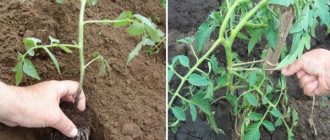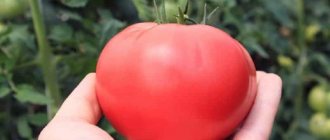Tomato Golden mother-in-law F1: variety description
This tomato is distinguished by early ripening of tomatoes - from the moment the first sprouts appear to the harvest of ripe products, it takes up to 3 months
. A similar ripening period is necessary when growing vegetable crops in regions with problematic agriculture, where the cold summer period is quite short, so vegetable crops with a long ripening period do not have time to produce the harvest in the planned volume.
Also, another advantage of the early ripeness of tomatoes is that the bushes have time to bear fruit before the time when “harmful” bugs or diseases appear in the garden plot.
Photo of tomato Golden mother-in-law
Tomato hybrid Golden Mother-in-law is classified as a determinate variety of tomatoes
.
Therefore, its compact bushes are limited in growth - the shoots grow no higher than 0.8 m, and the plant itself is powerful and strong. When grown in closed ground, the height of the stems of the Golden Mother-in-law tomato can reach 0.9-1.1 m.
In open ground, the bushes are low, with weak development of lateral shoots, so the Golden Mother-in-law tomato in such conditions does not need to form bushes and remove stepsons.
And in greenhouse conditions, the Golden Mother-in-law tomato bushes form no more than 2 shoots
, removing the lower leaves, and you should also tear off the resulting stepsons in a timely manner.
Common tomato Golden mother-in-law f1. Brief overview, description of characteristics - video
The foliage is small in size, elongated, slightly widening at the ends; wrinkles on the outer sides of the leaf blades are almost invisible. The color of the back side of the leaves is lighter than that of the outside. And the color of the foliage is rich emerald.
The first flower cluster with complex inflorescences is formed after 4-5 true leaves, and each subsequent one - after a couple of leaves. A total of 5 flower clusters are formed on the shoot; this is where the growth of the stem usually ends. In total, no more than 5 ovaries are formed in each bunch, which are firmly held on the stalks.
The shape of ripe tomatoes is round, proportionally folded, and characteristic ribbing is noticeable at the stalk.
On a note!
Ripe fruits are medium in size and slightly larger, their diameter is about 10 cm, and the average weight of the Golden Mother-in-law tomato is about 150 g, but the first fruits can ripen up to 200-210 g.
The skin of tomatoes is compacted, smooth, with a characteristic glossy shine, bright orange color with a golden tint. The peel does not crack during transportation or heat treatment.
The pulp is also compacted, with fairly thick walls, fleshy, with the same color as the skin.
Orange variety of tomato:
Golden Heart Tomato
Each tomato contains up to 4 seed chambers, each containing a small number of seeds. It will not be possible to use them for further planting, since this tomato is a hybrid, and the seeds of the second generation do not contain positive parental characteristics.
The ripened fruits of the Golden Mother-in-law tomato have a pleasant sweet and sour taste and a pleasant aroma.
Like other varieties of tomatoes with yellow-orange fruit color, Golden Mother-in-Law tomatoes contain approximately 6 times more beta-carotene than this vegetable with red tomatoes.
The harvested crop can be transported to any distance without losing its beautiful appearance and good taste.
The keeping quality of tomatoes is quite good.
Productivity
The Golden Mother-in-Law tomato can be grown in various Russian regions - in open ground and in greenhouse conditions, and the fruits ripen at approximately the same time.
On a note!
When 2-month-old seedlings are planted in open ground in the last ten days of May, the ripening harvest is harvested already in the second ten days of July.
From a tomato bush growing in open ground, up to 3 kg of fruit is usually collected, and when grown in greenhouse conditions - at least 4 kg of ripe products.
However, according to the description of the author of the hybrid, the yield of the Golden Mother-in-law tomato, subject to all agrotechnical measures in open beds, is about 4.5-5 kg of ripe fruit from each bush, and up to 6 kg in greenhouses.
From each square of area you can collect from 11 to 18 kg of ripe tomatoes.
Tomato Golden mother-in-law. Seed germination - video
How to grow tomatoes
The seedlings must be at least 50 days old, and the soil (at a depth of 12 cm) must be warmed to at least 12 C day and night.
At the time of transplantation, the seedlings already look quite strong, developed roots have entwined the entire pot, a thickened trunk, dark green leaves, a bud or a blossoming flower on the first cluster.
The planting site is chosen based on the sunniest and highest space on the site. Poor lighting reduces the sugar content and weight of the fruit.
Landing
A damp and cloudy day or evening is best for transplanting.
You can plant seedlings in a greenhouse or directly in open ground according to the 40x70 cm pattern.
The more stems, the greater the distance between the bushes.
- A glass of ash, humus, and special complex fertilizers from the store are poured into the hole.
- Then fill it with water, maybe more than once, so that the consistency of the soil is like sour cream.
- The bush (possibly with a clod of earth) is planted deep to the level of the first true leaf.
- At the roots, the soil with the roots must be squeezed with your fingers.
- Stepchildren (shoots from the axils of the stem) need to be removed, even very small ones.
The best bushes are planted in a row, and it is better to leave the weak ones at the edges
It is important to be careful, as infection can easily spread through injured roots.
It is recommended to mulch with dry grass, shavings, husks, sawdust, straw or inorganic materials (polyethylene with holes, agrofibre, etc.). A protective layer of mulch fights pests and weeds, prevents overheating and compaction.
Each stem needs a garter. In order not to damage the roots, the peg should be at a distance (15-20 cm) and higher than the bush. The trunk is tied around the stems with ropes or ribbons crossed in a figure eight.
There is no need to water or loosen the first 10 days after planting tomatoes.
Hilling is scheduled for the second week after transplantation.
- In the early morning (2 hours before dawn) or late evening, water the soil so that it is soft enough.
- Weeds are pulled out by hand.
- Loosen with a convenient tool.
- Sprinkle the trunk with a mound of loose earth in the form of a mound of about 20 cm.
This process is usually combined with humus fertilizer. You can repeat the activity every week after watering or rain.
Fertilizing with any microelements is done when the first true leaf appears, sprayed 2-3 hours after watering. There is no need to fill the tomatoes. Once every 5-10 days is enough, depending on the weather, and if you notice that the leaves are a little wilted.
Possible difficulties
From an excess of water, the seeds begin to suffocate, so the seedling pots should spill through, and the excess water should flow freely into the pan. Water only with warm, settled (without bleach) clean water.
It is useful to unfold and swap pots to change the lighting angle. You can also put something under them if the window sill is cold. Correct actions in the initial period of caring for seedlings are actually much more important than all other activities with an adult plant.
You cannot plant tomatoes next to potatoes, because they are the first to be affected by late blight. Excess dampness and moisture can cause flowers to fall off, delayed fruit set and the appearance of fungus. 3-5 liters of water per bush is enough, and during flowering generally reduce watering to 1-2 liters. But they don’t like to drink tomatoes more than twice a week.
Diseases and pests
Prone to late blight - the fruits are covered with brown and brown spots, the stems and leaves have dark stripes, and the bottom of the leaf is covered with a white fungal coating. They are treated with special preparations – fungicides. Picked fruits can also be susceptible to fungus.
Prevention consists of moderate amounts of fertilizer and water. Avoid crowding of bushes and immediately remove and burn all diseased plants.
Parasites like to eat leaves and stems:
- Colorado potato beetles;
- slugs;
- spider mites;
- whiteflies;
- caterpillars;
- aphid.
Insecticides are used to control insects.
Nuances for open ground and greenhouses
When growing in a greenhouse, avoid condensation and ventilate from the direction opposite to the wind direction. If it rains, the greenhouse is not watered. Excess moisture directly affects the taste, making tomatoes more bland.
Area of application of fruits
Most yellow fruits of other tomatoes lack the sourness characteristic of tomatoes, but with the Golden Mother-in-law everything is different - there is acid in tomatoes
. Therefore, these fruits can be added to salads, eaten fresh, canned, or pickled. The harvested fruit produces a delicious, unusually colored juice, as well as various sweet and sour sauces.
Tomatoes of the Golden Mother-in-Law variety are hypoallergenic, have a pleasant taste, and contain a large number of various beneficial substances, so they are recommended to be eaten by children, and also added when compiling dietary menus.
Diseases and pests
Like many other hybrid tomatoes, Golden Mother-in-law has high immunity, so it is practically not affected by the following diseases:
- Alternaria blight;
- tobacco mosaic virus;
- bacterial cancer.
To prevent the bushes of this hybrid from being affected by late blight, they are treated for preventive purposes with appropriate fungicidal preparations.
Advantages and disadvantages
Reviews from vegetable growers about the Golden Mother-in-law hybrid tomato are generally positive:
- early ripening of products;
- good taste of ripe fruits;
- excellent presentation of tomatoes;
- productivity does not depend on changes in weather conditions;
- the harvested crop can be transported to any distance and stored in appropriate conditions for quite a long time;
- resistance to major tomato diseases.
There are practically no downsides to this variety.
Growing tomato Golden Mother-in-law
The Golden Mother-in-Law tomato should be grown using seedlings.
. Since this tomato is a hybrid, seeds cannot be collected from the garden. And all purchased seed material undergoes pre-sowing preparation at the seed manufacturer.
Therefore, before planting, you can only soak the seeds so that they germinate faster in the future.
It is also advisable to purchase the nutrient substrate in a specialized store.
Yellow tomatoes. Something about growing and specifically about the hybrid - video
The soil is laid out in prepared containers, seed material is placed in it, covered with a thin layer of soil on top, and the soil is moistened with a spray bottle. Then the containers are covered with polyethylene or glass and placed in a warm, bright place until the seeds germinate. Typically, sprouts appear 6-8 days after sowing the seeds.
Important!
The germination rate of Golden Mother-in-law tomato seed is no less than 95%.
Further growing seedlings require:
- regular watering as the soil dries out;
- During the day, plants should be well illuminated by sunlight for 12 hours. If there is not enough natural light, then phytolamps or fluorescent lamps should be placed next to the containers to illuminate the seedlings;
- a couple of fertilizers during plant growing, containing phosphorus, nitrogen and potassium;
- 10-12 days before transplanting the seedlings to a permanent place, they are hardened off by taking them out into the fresh air for a short time at first, bringing the time the plants spend in the fresh air to 6-7 hours.
How to get seedlings
Designed for cultivation in open ground, but also possible in greenhouses (preferably film ones). Everything from the moment of sprouting to the ripening of tomatoes takes 85-90 days.
Approximately 9-12 days for planting and establishment of seedlings, plus 2 months for seedling germination (45-55 days) and several weeks for fruit ripening.
For open ground, seedlings are prepared from mid-March or in the 1st ten days of April.
Seed preparation:
- Dry seeds need to be washed in potassium permanganate. To prepare a solution (0.5%) you will need 200 ml of water and 1 gram of pharmaceutical manganese in crystals.
- Leave them in it for 15-20 minutes and rinse with plenty of water.
- Then soak for a couple of hours in a hormonal extract to accelerate germination for 4-5 days.
These manipulations will increase survival rate and protect seedlings from diseases in the first few weeks.
Although, you can do without pre-sowing treatment, if you are sure that this is a proprietary product in a closed shell, it was stored correctly and did not miss the expiration date.
Next, the seeds are placed in a separate container with water, which is covered with gauze so that they do not float.
Container and soil
The container for seedlings can be any size , be it a large container or individual 100 ml pots. The distance between seedlings is small (from 2 cm), the roots are poorly developed, but the main thing is that sufficient oxygen access is ensured. And after the first two true leaves appear, the roots begin to grow and require 4 times more space. Transplant into containers or individual pots up to 500 ml.
Sowing:
- There is no need to wait for the seed to germinate and, on the second day, plant it in special universal fertile soil about 2 cm deep.
- It is important that the sprout itself sheds its skin after sprouting outward, so each hole needs to be lightly compacted.
- The sowing is covered with film, but care is taken to ensure that the seeds do not steam. The temperature must be at least 15°C and no more than 25°C.
- When the shoots appear, the film is removed and the temperature is reduced to 16° C during the day and 14° C at night, this is done for the full growth and development of the root system. It is these temperature indicators that contribute to the proper absorption of minerals.
It is important that there is enough not only moisture, but also light. In February-March, seedlings should be illuminated for at least 12 hours during the day.
Aftercare
In the next stage, the plants are transplanted into new pots, at the same time diving the roots (by 1-2 cm) to grow in width and the appearance of lateral shoots.
This is an important point. Reducing part of the root system makes the plant older and speeds up the ripening period of tomatoes.
- 2 hours before transplanting, the soil needs to be moistened in order to remove the sprout more carefully. A teaspoon or toothpick is used as a tool.
- Immediately after picking and transplanting, it is necessary to start feeding with nutritional mixtures, and to increase the mass of the roots, lower the temperature. Therefore, the pots are moved to a dark place for a couple of days.
- A week or two before transplanting into open ground, young plants are hardened off by taking them out into the open air for several hours, fertilized less with nitrogen and watering is reduced.
Apple tree Uslada: variety description, photos, reviews
Transplantation to a permanent place
Golden mother-in-law tomato seedlings are transplanted to a permanent place at the age of 55-60 days
. The bushes are planted in rows (2 rows per bed). The distance between adjacent plants in a row is 0.5 m, the distance between rows is 0.6 m. The row spacing is at least 0.7 m.
Place 1 tbsp in each planting hole. l. ammonium nitrate, water it with water, then roll over the tomato bushes along with the earthen lump. Add a layer of soil on top, compact it and carry out another watering.
Agricultural technology
Mother-in-law tomatoes are undemanding in terms of soil composition, but grow and bear fruit better on neutral and slightly acidic soil. Seeds are sown for seedlings at the end of March, in open ground - at the beginning of May.
Seeds are sown in a container with soil to a depth of 1-1.5 cm. To create optimal conditions for germination, the containers are covered with film. The room temperature must be at least 21°C. After germination, the seedlings are moved to a lighted place. During this period, it is necessary to regularly water the seedlings as the soil dries out. When 1-2 true leaves are formed, the seedlings dive.
Seedlings are planted in the ground 55 days after emergence. For planting tomatoes, use a 40×70 pattern.
It is enough to moisten the soil once a week. Excessive waterlogging of the soil creates favorable conditions for the development of black rot on the stem, as a result of which the plant disappears. It is also necessary to remove weeds and loosen the soil shallowly so that oxygen can penetrate to the roots.
During the entire period before the start of fruiting, fertilizing is applied 3-4 times, maintaining an interval of 2 weeks. A simple recipe for fertilizer is to dilute 1 tbsp in a bucket of water. l. superphosphate. You will need 10 liters. nutrient liquid per 1 sq. m.
Tomato Golden mother-in-law in the garden
It is recommended to spray the plantings with an aqueous solution of boric acid - this improves flowering. Spraying should be carried out in the morning, while the sun is not too active, or in cloudy weather, since interacting with the sun's rays, the solution can cause burns on the leaves and stems of tomatoes.
How to prepare the solution:
- 1 l. warm water;
- 1 gr. boric acid.
Mix the ingredients until smooth. The solution is ready.
There is no need to shoot tomatoes in open ground, but if the side shoots are not removed, the growth of the plant stops. When growing tomatoes in greenhouses, it is important to plant shoots every 5-7 days. This procedure is carried out in the morning in dry weather, the plant is formed into two stems.
Tomatoes can be pickled, prepared into salads and sauces.
Further care for the Golden Mother-in-law tomato
With good proper care, you can collect at least 3.5 kg of ripe fruits from each bush, so you need to follow the watering regime, feed them on time and loosen the soil in a timely manner.
Irrigation regime
Water the Golden Mother-in-law tomato once every 6-8 days, focusing on soil moisture. During the rainy season, it is better to reduce the number of waterings, otherwise the tomato bushes may be affected by fungal diseases.
After each watering, the soil is loosened and weeds are removed. Then you can lay out a layer of mulch from straw or mown grass in the root zone.
Formation of bushes
In open ground, this tomato does not require the formation and removal of stepsons
. You can also not tie up the shoots, just place supports under the bunches with ripening tomatoes.
On a note!
In greenhouse conditions, bushes should be maintained in 2 shoots, subsequently removing all excess shoots and foliage in the lower part of the bush as the fruits ripen.
Feeding tomatoes
While growing this tomato, it is recommended to apply complex mineral fertilizers to the beds every 12-14 days. The last fertilizing for Golden Mother-in-law tomatoes should be applied 10 days before harvesting the first fruits.
Where to plant, how to care
This variety is not much different in terms of care from other tomatoes. Mulch the soil if possible. Water once a week, and also loosen the beds to saturate the roots with oxygen and remove weeds.
When growing in a greenhouse, special attention is paid to humidity and temperature. The presence of a draft is not a hindrance for tomatoes, and therefore you can safely open windows indoors, lift the film, etc.
Airing is carried out 2 hours after the plants are watered
Maintaining humidity during the flowering phase is very important; wet pollen does not contribute to high-quality pollination.
If you plan to plant tomatoes in an open area, then preference is given to free places, the main thing is that they have protection from the cold wind. A low-lying and damp area is not suitable for vegetable crops.
An equally important issue remains feeding tomatoes after planting in the ground. In spring, three-time application of fertilizers is recommended:
- the first fertilizing is applied 14 days after planting the seedlings on the site;
- the second feeding is organized in the flowering phase so that fruit ovaries are formed;
- the third feeding occurs at the time of fruit formation.
As for the amount of fertilizer, it all depends on the soil layer. If the soil is chernozem, then the use of fertilizing is impractical due to the large amount of nutrients in the soil. Tomatoes growing in sandy loam soil will need regular fertilization every 14 days. That's probably all you need to know about feeding tomatoes after planting them in the ground.











